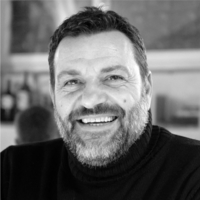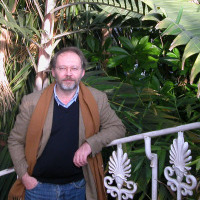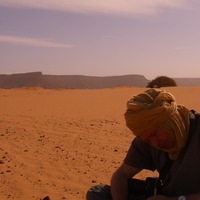Papers by Leandro Infantini

Quaternary International, 2013
This paper will focus on the ecology of the first Anatomically Modern Humans in SW Iberia based o... more This paper will focus on the ecology of the first Anatomically Modern Humans in SW Iberia based on the rock shelter of Vale Boi (Algarve, Portugal), a site with a long stratigraphic record starting with Late Middle Paleolithic followed by early Gravettian, Proto-Solutrean, Solutrean, and Magdalenian. Early Gravettian remains are present in various areas and different levels of the site, and are dated to c. 32 ka cal BP, corresponding to the earliest modern human occupation in SW Iberia. These communities most likely came from the Iberian Mediterranean coast as bone technology and body ornaments seem to confirm. The Gravettian of Vale Boi provides clear evidence of an intensification and diversification of dietary resources from very early, including the use of grease-rendering. Here, reconstruction of the Gravettian human ecology at Vale Boi is based on the diversity of human occupations, focusing mostly on diachronic changes in the patterns of resources acquisition and land-use, but also on subsistence, technological, social and symbolic elements.

Revista Arqueologia Pública, 2015
Os sistemas de Informações Geográficas (SIG ou GIS - Geographic Information System, em inglês) sã... more Os sistemas de Informações Geográficas (SIG ou GIS - Geographic Information System, em inglês) são sistemas de informação espacial, procedimentos computacionais e recursos humanos que permitem a análise, gestão ou representação do espaço e dos fenômenos que nele ocorrem. Na arqueologia, vem sendo utilizado desde a década de 60 do século XX, em campos tais como a criação de modelos preditivos de terreno, análises geomorfológicas e hidrológicas de sítios e reconstruções paleoambientais, alcançando resultados amplos na interpretação dos contextos investigados. Nesse sentido, a oficina apresentada na II Semana de Arqueologia da Unicamp, vinculando-se ao eixo temático Diálogos teórico-metodológicos contemporâneos, buscou demonstrar o uso dos chamados Sistemas de Informação Geográfica (SIG) na Arqueologia, tanto na detecção de áreas com potencial arqueológico, como na interpretação de sítios e suas relações ambientais. O curso foi dividido em duas partes, sendo a primeira introdutória, de...

Conservação Pública e Patrimônio como marca de lugar: diálogos com o campo da arqueologia, 2021
Resumo: Tomando como exemplo o contexto de desenvolvimento e expansão dos novos campos epistemoló... more Resumo: Tomando como exemplo o contexto de desenvolvimento e expansão dos novos campos epistemológicos e sociais que a arqueologia galgou a partir do trabalho voltado para atender demandas públicas, este artigo propõe uma análise quanto à expansão da esfera de atuação da conservação e restauração de bens culturais, em um exercício aproximado de reflexão do campo para atuar com demandas públicas em contextos comunitários e plurais. Transitando por autores clássicos que definem a guinada da arqueologia para uma aproximação direta com o interesse público na construção de sentidos dados ao patrimônio a partir da cultura material, colocamos paralelamente a (re)construção da teoria de conservação e restauração de Salvador Muñoz-Viñas. O autor amplifica a intenção do tratamento dado aos bens culturais enquanto estreita laços com aqueles a quem se destinam, abrindo caminho para um exercício participativo que une a expertise profissional ao público que, ao se acercar dos processos, se identifica e se apropria do patrimônio, formatando novos sistemas e ordenando uma memória social, entendida aqui não como percepção cognitiva, mas como esforço coletivo de perpetuação de um patrimônio identitário. Respaldado pela teórica Barbara Appelbaum, que reforça a importância de elementos externos como a consideração humana aos objetos em si e sua materialidade física, tecemos, por fim, considerações a respeito da importância de ligar a práxis da conservação e restauração de bens culturais ao público, e compreender que tratar as esferas do presente de maneira participativa não constitui um território de disputa ou descaracterização, mas sim como espaço de herança em constante construção.
Abstract: Taking as an example the context of development and expansion of new epistemological and social fields that archeology came up from the work aimed at meeting public demands, this article proposes an analysis regarding the expansion of the sphere of action of conservation and restoration of cultural goods, in an approximate exercise of reflection by the field to act with public demands in community and plural contexts. Moving through classic authors who define the shift in archeology towards a direct approach to public interest in the construction of meanings given to heritage based on material culture, we put in parallel the (re) construction of Salvador Muñoz-Viñas’s theory of conservation and restoration. The author amplifies the intention of the treatment given to cultural goods while strengthening ties with those for whom they are intended, opening the way for a participatory exercise that unites professional expertise to the public, who, when approaching the processes, identify and appropriate the heritage, shaping new systems and ordering a social memory, understood here not as cognitive perception, but as a collective effort to perpetuate an identity heritage. Supported by the theorist Barbara Appelbaum, who reinforces the importance of external elements such as human consideration of the objects themselves and their physical materiality, we finally make considerations about the importance of linking the praxis of the conservation and restoration of cultural goods to the public, and understand that treating the spheres of the present in a participatory manner does not constitute a territory of mischaracterization, but rather as a space of inheritance in constant construction.
Dissertacao de mest., Geomatica (Analises de Sistemas Ambientais), Faculdade de Ciencias e Tecnol... more Dissertacao de mest., Geomatica (Analises de Sistemas Ambientais), Faculdade de Ciencias e Tecnologia, Univ. do Algarve, 2012

Coastal Research Library, 2020
People have lived along the Portuguese coast at least since Marine Isotope Stage (MIS) 5, over 1... more People have lived along the Portuguese coast at least since Marine Isotope Stage (MIS) 5, over 100,000 years ago. While there are many known sites and archaeological evidence of human settlement on land, there are only a handful of known submerged or near- submerged locations, and these are all in the present-day intertidal zone. Throughout the period, diet was based on both terrestrial and marine mammals as well as fish and shellfish. This dietary regime was already in existence when Neanderthals populated the region. It appears that marine foods started to be used more frequently when the first anatomically modern humans arrived, some 33,000 years ago. Among the Mesolithic people who lived along the estuaries of the major rivers, marine food frequently composed c. 50% of the diet. With the introduction of agriculture, coastal resources became less important, although some submerged sites of Neolithic date testify to habitation directly at the seashore. Despite the current absence of known underwater pre-historic sites, apart from those in the intertidal zone, recent studies of offshore topography have identified a number of areas with good potential for archaeological prospection, including cliff lines with underwater caves and drowned river valleys.

Tomando como exemplo o contexto de desenvolvimento e expansão dos novos campos epistemológicos e ... more Tomando como exemplo o contexto de desenvolvimento e expansão dos novos campos epistemológicos e sociais que a arqueologia galgou a partir do trabalho voltado para atender demandas públicas, este artigo propõe uma análise quanto à expansão da esfera de atuação da conservação e restauração de bens culturais, em um exercício aproximado de reflexão do campo para atuar com demandas públicas em contextos comunitários e plurais. Transitando por autores clássicos que definem a guinada da arqueologia para uma aproximação direta com o interesse público na construção de sentidos dados ao patrimônio a partir da cultura material, colocamos paralelamente a (re)construção da teoria de conservação e restauração de Salvador Muñoz-Viñas. O autor amplifica a intenção do tratamento dado aos bens culturais enquanto estreita laços com aqueles a quem se destinam, abrindo caminho para um exercício participativo que une a expertise profissional ao público que, ao se acercar dos processos, se identifica e se apropria do patrimônio, formatando novos sistemas e ordenando uma memória social, entendida aqui não como percepção cognitiva, mas como esforço coletivo de perpetuação de um patrimônio identitário. Respaldado pela teórica Barbara Appelbaum, que reforça a importância de elementos externos como a consideração humana aos objetos em si e sua materialidade física, tecemos, por fim, considerações a respeito da importância de ligar a práxis da conservação e restauração de bens culturais ao público, propondo que tratar as esferas do presente de maneira participativa não implica perigo de descaracterização, mas sim um espaço de herança em constante construção.

Hibridación Cultural. Un análisis de superposición espacio-temporal en Argentina, 2018
INTRODUCCIÓN El municipio de Lanús se encuentra dentro de la provincia de Buenos Aires, hacia el ... more INTRODUCCIÓN El municipio de Lanús se encuentra dentro de la provincia de Buenos Aires, hacia el sur de la Ciudad Autónoma de Buenos Aires. Logra su autonomía el 29 de septiembre de 1944, y para ese entonces su nombre sería "4 de Junio"; la designación como "Lanús" es en honor a Anacarsis Lanusse, comerciante Argentino que adquirió tierras en la zona hacia 1848 (DECRETO Nº 461, 1955; DE PAULA et.al., 1974). Actualmente aún se conservan algunos restos de lo que fuera su estancia, ubicados precisamente en la calle Presidente Quintana 591, otras partes de la misma han sido demolidas, como resultado del crecimiento de la ciudad. Modificaciones que comienzan luego de 1911, año en que la estancia es vendida a la familia Martínez de Hoz, llegando posteriormente al loteo y remate de la propiedad (MARTÍNEZ DE HOZ, 1911). A partir de las modificaciones sobre el paisaje Lanusenses, que llevaron a la demolición casi por completo de lo que fuera la estancia de los Lanusse, se realizará un mapa que permita identificar la disposición y los límites que tenía la estancia sobre el trazado urbano actual. Para ello se recurrirá al uso de Sistemas de Información Geográfica (SIG). La perspectiva con la que se aborda este análisis parte de la concepción de BHABHA (2002) sobre un tercer espacio, en el cual pasado y presente se encuentran superpuestos. Esta cultura "híbrida", aún según BHABHA, permite dar cuenta de que en los paisajes que observamos conviven ambos tiempos. 2. METODOLOGIA La arqueología de la arquitectura considera que las construcciones son elementos activos que interactúan con la dinámica de las personas (ZARANKIN, 2003 Y 2009). En términos de HODDER (1998), los elementos materiales son sistemas simbólicos en acción. Por ello, el estudiar las modificaciones que ocurren sobre esos simbolismos puede dar cuenta de las dinámicas sociales y por lo tanto de las transformaciones espacio-temporales. Dicho de otra manera, en este caso en particular aportan a la comprensión del crecimiento poblacional y a la constitución de uno de los sectores céntricos del partido.

GEOLOCALIZAÇÃO DE SÍTIOS ARQUEOLÓGICOS POR GEORREFERENCIAMENTO DE MAPAS HISTÓRICOS: AS CHARQUEADAS DA REGIÃO DE PELOTAS, RS, 2019
INTRODUCCIÓN: O presente projeto tem por objetivo provocar novas interpretações acerca da históri... more INTRODUCCIÓN: O presente projeto tem por objetivo provocar novas interpretações acerca da história da diáspora africana (FERREIRA, 2015; FERREIRA, FUNARI, 2015; FUNARI, FERREIRA, 2016) a partir do georeferenciamento e da cartografia e subsequente interpretação arqueológica e espacial do modo de produção escravista como constituído no contexto das Charqueadas instaladas ao sul do estado do Rio Grande do Sul, durante os séculos XVIII e XIX. Para tanto, o presente projeto criou e gere, com o apoio de um Sistema de Informação Geográfico (SIG), um banco de dados geográfico das charqueadas e das estruturas relacionadas com a atividade charqueadora da região.
Como forma de delimitar geograficamente e cronologicamente a área de estudo, o presente projeto pretende estudar o contexto relacionado às charqueadas na bacia do canal de São Gonçalo entre os anos de 1780 a 1888.
Esta pesquisa se insere no projeto "O Pampa Negro: Arqueologia da Escravidão na Região Meridional do Rio Grande do Sul (1780-1888)", desenvolvido no Laboratório de Estudos Interdisciplinares de Cultura Material (LEICMA), coordenado pelo Prof. Dr. Lucio Menezes Ferreira.

The environmental shifts during the Late Pleistocene had major influences in the landscape and, c... more The environmental shifts during the Late Pleistocene had major influences in the landscape and, consequently, in the available resources. This had direct impact on human behavior and ecology, requiring people to constantly adjust to new economical conditions. In coastal areas, the retreat of the shoreline during the colder phases might have made available presently underwater raw material sources in the form of outcrops and gravels, eventually making it easier to gather lithic raw materials.
In this paper, we present our preliminary results on the diachronic variability of raw materials in Vale Boi. Vale Boi is a coastal site, located 2.5 km from the present coastline, in the margins of a freshwater stream. The site has three different loci, all rich in lithics, fauna (including marine), bone tools, adornments, charcoal, and ochre, and evidence of continuous human occupation from c. 33 to 15.6 ka cal BP. This chronostratigraphic record makes it a perfect study case for the understanding of coastal populations' behavior and economy throughout the Upper Paleolithic.
Our objective is to infer the territory of resources exploitation, landscape, and economic patterns. Raw material sources are usually fixed points on the landscape (in contrast to other resources such as fauna and flora) and, therefore, are one of the best ways of understanding how people moved in the landscape and, consequently, to infer past human behavior. We used a macroscopic approach in both the archaeological and the geological record in order to correlate sources and artifacts. Despite the absence of detailed quantitative data on each chert type, our results show that the hunter–gatherers who occupied Vale Boi during the Upper Paleolithic not only used several raw materials but also a variety of sources of the same raw material. This happened both diachronically and synchronically, suggesting that not only the complete sequence as well as each archaeological layer seem to have had a considerable economic complexity with the use of adjacent and distal sources. With this paper, we aim to present updated information on the variability of raw materials at Vale Boi, including the chert assemblages, along with new chert sources in order to establish a basis for a future detailed study on the raw material sourcing at the site.

During the Last Glacial Maximum (LGM) large portions of the continental shelves were emerged due ... more During the Last Glacial Maximum (LGM) large portions of the continental shelves were emerged due to a wide marine regression. Accordingly, the landscape and therefore prehistoric heritage and palaeoenvironmental indicators are currently submerged and potentially preserved, being necessary investigations in order to study and restore this heritage. Aiming to contribute for the understanding of the underwater landscape, this work presents preliminary data about research in the submerged area of the Armação de Pêra bay (Southern Portugal). However, due to difficulties on working in underwater areas, from the morphological characterization to sampling for textural analysis, new approaches were needed to investigate this area. Characterization and morphological analysis of the study area were performed in GIS environment using a Digital Terrain Model (DTM) built from bathymetric data obtained by remote sensing. Based on this analysis, the submerged area of the Bay of Armação de Pera has a morphology compatible with the development of a coastal lagoon system during the Pleistocene, sheltered by a spit bar. As observed in petrographic and sedimentological analysis carried out in samples taken in diving, the sands of the sedimentary body have suffered a rapid cementation by calcium carbonate that gave them strength to erosion by waves and currents.

This paper will focus on the ecology of the first Anatomically Modern Humans in SW Iberia based o... more This paper will focus on the ecology of the first Anatomically Modern Humans in SW Iberia based on the rock shelter of Vale Boi (Algarve, Portugal), a site with a long stratigraphic record starting with Late Middle Paleolithic followed by early Gravettian, Proto-Solutrean, Solutrean, and Magdalenian. Early Gravettian remains are present in various areas and different levels of the site, and are dated to c. 32 ka cal BP, corresponding to the earliest modern human occupation in SW Iberia. These communities most likely came from the Iberian Mediterranean coast as bone technology and body ornaments seem to confirm. The Gravettian of Vale Boi provides clear evidence of an intensification and diversification of dietary resources from very early, including the use of grease-rendering. Here, reconstruction of the Gravettian human ecology at Vale Boi is based on the diversity of human occupations, focusing mostly on diachronic changes in the patterns of resources acquisition and land-use, but also on subsistence, technological, social and symbolic elements.

Mudanças ambientais e interação humana na fachada atlântica ocidental, Oct 2012
Durante o Último Máximo Glacial (UMG) vastas porções das plataformas continentais encontravam-se ... more Durante o Último Máximo Glacial (UMG) vastas porções das plataformas continentais encontravam-se emersas devido à regressão marinha de grande amplitude. Deste modo, uma grande parte da paisagem e consequentemente do património pré-histórico e paleoambiental está presentemente submerso e potencialmente preservado, sendo necessárias investigações no sentido de o estudar e recuperar. Neste contexto, e de forma a contribuir para o conhecimento de paisagens submersas, o objetivo deste trabalho é apresentar e discutir os dados preliminares da investigação efetuada na área submersa da Baía de Armação de Pêra (Sul de Portugal). Devido a dificuldades inerentes ao trabalho em zonas submersas, desde a caracterização morfológica à recolha de amostras para análise textural, foram necessárias novas abordagens metodológicas para a caracterização da área de estudo. A caracterização e análise morfológica da área de estudo, foi realizada em ambiente SIG utilizando um Modelo Digital de Terreno (MDT) da região construído a partir de dados batimétricos obtidos por deteção remota. Com base nesta análise, a zona submersa da Baía de Armação de Pêra apresenta uma morfologia compatível com o desenvolvimento de um sistema lagunar durante o Plistocénico, abrigado por uma restinga arenosa. Tal como observado nas análises sedimentológicas e petrográficas preliminares, realizadas em amostras colhidas em mergulho, as areias da restinga sofreram uma rápida cimentação por carbonato de cálcio que lhes conferiu resistência mecânica à erosão pelas ondas e correntes.

Atas das 5ª Jornadas Jornadas de Software Aberto para Sistemas de Informação Geográfica, Nov 2012
Devido ao potencial arqueológico e paleoambiental do Algarve, foi desenvolvido um SIG aplicado ao... more Devido ao potencial arqueológico e paleoambiental do Algarve, foi desenvolvido um SIG aplicado ao período pré-histórico utilizando softwares abertos/livres. Os objectivos deste SIG são gerir as informações altimétricas e batimétricas e os sítios arqueológicos da região, assim como investigar a relação destes sítios com a linha de costa, e possibilitar a identificação de sítios arqueológicos ou zonas submersas com indicadores paleoambientais. Neste contexto, utilizaram-se diversas ferramentas computacionais abertos, como os softwares Quantum GIS e Mirone em conjunto com dados de acesso livre, como imagens do Landsat7 e Modelos Digitais de Terreno (MDT) do Algarve e do SRTM. Baseado nestes dados e nos objectivos, várias operações foram realizadas de modo a simular a linha de costa ao longo da pré-história e analisar as relações espaciais dos sítios arqueológicos. Por outro lado, este SIG permitiu a identificação e investigação da paleorestinga submersa na baía de Armação de Pêra através da análise morfológica e do planeamento de missões de recolha de amostras subaquáticas.
Durante o Tardiglaciar, vastas porções da plataforma continental do Algarve encontravam-se emersa... more Durante o Tardiglaciar, vastas porções da plataforma continental do Algarve encontravam-se emersas devido variações do nível do mar. Neste sentido, as relações entre as ocupações humanas e o território devem ser interpretadas tendo em conta a ocorrência destefenómeno. O presente trabalho tem como objectivo analisar, forma preliminar, as relações existentes entre as alterações da linha de costa do actual território do Algarve e as comunidades humanas que ocupavam o mesmo território, através da tecnologia lítica e da utilização de um Sistema de Informação Geográfico (SIG), durante o Tardiglaciar. De forma a compreender melhor a dimensão e a distribuição espacial dos sítios arqueológicos e as interacções com a linha costa, torna-se necessário a criação de um SIG a fim de criar um quadro mas preciso do paleoambiente desta região.
Poster by Leandro Infantini
Geographic Information System (GIS) are the computational tools of geoprocessing that enable comp... more Geographic Information System (GIS) are the computational tools of geoprocessing that enable complex analysis by integrating multiple data sources with the creation of georeferenced databases.
De forma a contribuir para o conhecimento de paisagens submersas e para a investigação paleoambie... more De forma a contribuir para o conhecimento de paisagens submersas e para a investigação paleoambiental, o objetivo deste trabalho é apresentar os resultados da investigação efetuada na área submersa da Baía de Armação de Pêra (Sul de Portugal).
video by Leandro Infantini











Uploads
Papers by Leandro Infantini
Abstract: Taking as an example the context of development and expansion of new epistemological and social fields that archeology came up from the work aimed at meeting public demands, this article proposes an analysis regarding the expansion of the sphere of action of conservation and restoration of cultural goods, in an approximate exercise of reflection by the field to act with public demands in community and plural contexts. Moving through classic authors who define the shift in archeology towards a direct approach to public interest in the construction of meanings given to heritage based on material culture, we put in parallel the (re) construction of Salvador Muñoz-Viñas’s theory of conservation and restoration. The author amplifies the intention of the treatment given to cultural goods while strengthening ties with those for whom they are intended, opening the way for a participatory exercise that unites professional expertise to the public, who, when approaching the processes, identify and appropriate the heritage, shaping new systems and ordering a social memory, understood here not as cognitive perception, but as a collective effort to perpetuate an identity heritage. Supported by the theorist Barbara Appelbaum, who reinforces the importance of external elements such as human consideration of the objects themselves and their physical materiality, we finally make considerations about the importance of linking the praxis of the conservation and restoration of cultural goods to the public, and understand that treating the spheres of the present in a participatory manner does not constitute a territory of mischaracterization, but rather as a space of inheritance in constant construction.
Como forma de delimitar geograficamente e cronologicamente a área de estudo, o presente projeto pretende estudar o contexto relacionado às charqueadas na bacia do canal de São Gonçalo entre os anos de 1780 a 1888.
Esta pesquisa se insere no projeto "O Pampa Negro: Arqueologia da Escravidão na Região Meridional do Rio Grande do Sul (1780-1888)", desenvolvido no Laboratório de Estudos Interdisciplinares de Cultura Material (LEICMA), coordenado pelo Prof. Dr. Lucio Menezes Ferreira.
In this paper, we present our preliminary results on the diachronic variability of raw materials in Vale Boi. Vale Boi is a coastal site, located 2.5 km from the present coastline, in the margins of a freshwater stream. The site has three different loci, all rich in lithics, fauna (including marine), bone tools, adornments, charcoal, and ochre, and evidence of continuous human occupation from c. 33 to 15.6 ka cal BP. This chronostratigraphic record makes it a perfect study case for the understanding of coastal populations' behavior and economy throughout the Upper Paleolithic.
Our objective is to infer the territory of resources exploitation, landscape, and economic patterns. Raw material sources are usually fixed points on the landscape (in contrast to other resources such as fauna and flora) and, therefore, are one of the best ways of understanding how people moved in the landscape and, consequently, to infer past human behavior. We used a macroscopic approach in both the archaeological and the geological record in order to correlate sources and artifacts. Despite the absence of detailed quantitative data on each chert type, our results show that the hunter–gatherers who occupied Vale Boi during the Upper Paleolithic not only used several raw materials but also a variety of sources of the same raw material. This happened both diachronically and synchronically, suggesting that not only the complete sequence as well as each archaeological layer seem to have had a considerable economic complexity with the use of adjacent and distal sources. With this paper, we aim to present updated information on the variability of raw materials at Vale Boi, including the chert assemblages, along with new chert sources in order to establish a basis for a future detailed study on the raw material sourcing at the site.
Poster by Leandro Infantini
video by Leandro Infantini
Abstract: Taking as an example the context of development and expansion of new epistemological and social fields that archeology came up from the work aimed at meeting public demands, this article proposes an analysis regarding the expansion of the sphere of action of conservation and restoration of cultural goods, in an approximate exercise of reflection by the field to act with public demands in community and plural contexts. Moving through classic authors who define the shift in archeology towards a direct approach to public interest in the construction of meanings given to heritage based on material culture, we put in parallel the (re) construction of Salvador Muñoz-Viñas’s theory of conservation and restoration. The author amplifies the intention of the treatment given to cultural goods while strengthening ties with those for whom they are intended, opening the way for a participatory exercise that unites professional expertise to the public, who, when approaching the processes, identify and appropriate the heritage, shaping new systems and ordering a social memory, understood here not as cognitive perception, but as a collective effort to perpetuate an identity heritage. Supported by the theorist Barbara Appelbaum, who reinforces the importance of external elements such as human consideration of the objects themselves and their physical materiality, we finally make considerations about the importance of linking the praxis of the conservation and restoration of cultural goods to the public, and understand that treating the spheres of the present in a participatory manner does not constitute a territory of mischaracterization, but rather as a space of inheritance in constant construction.
Como forma de delimitar geograficamente e cronologicamente a área de estudo, o presente projeto pretende estudar o contexto relacionado às charqueadas na bacia do canal de São Gonçalo entre os anos de 1780 a 1888.
Esta pesquisa se insere no projeto "O Pampa Negro: Arqueologia da Escravidão na Região Meridional do Rio Grande do Sul (1780-1888)", desenvolvido no Laboratório de Estudos Interdisciplinares de Cultura Material (LEICMA), coordenado pelo Prof. Dr. Lucio Menezes Ferreira.
In this paper, we present our preliminary results on the diachronic variability of raw materials in Vale Boi. Vale Boi is a coastal site, located 2.5 km from the present coastline, in the margins of a freshwater stream. The site has three different loci, all rich in lithics, fauna (including marine), bone tools, adornments, charcoal, and ochre, and evidence of continuous human occupation from c. 33 to 15.6 ka cal BP. This chronostratigraphic record makes it a perfect study case for the understanding of coastal populations' behavior and economy throughout the Upper Paleolithic.
Our objective is to infer the territory of resources exploitation, landscape, and economic patterns. Raw material sources are usually fixed points on the landscape (in contrast to other resources such as fauna and flora) and, therefore, are one of the best ways of understanding how people moved in the landscape and, consequently, to infer past human behavior. We used a macroscopic approach in both the archaeological and the geological record in order to correlate sources and artifacts. Despite the absence of detailed quantitative data on each chert type, our results show that the hunter–gatherers who occupied Vale Boi during the Upper Paleolithic not only used several raw materials but also a variety of sources of the same raw material. This happened both diachronically and synchronically, suggesting that not only the complete sequence as well as each archaeological layer seem to have had a considerable economic complexity with the use of adjacent and distal sources. With this paper, we aim to present updated information on the variability of raw materials at Vale Boi, including the chert assemblages, along with new chert sources in order to establish a basis for a future detailed study on the raw material sourcing at the site.
Event: VIII Congresso Internazionale di Studi Fenici e Punici
Organisation: Sassari, Dipartimento di Storia, Scienze dell'Uomo e della Formazione
Location: Carbonia-Sant'Antioco, Sardinia, Italy
Conference Date: October 21-26, 2013